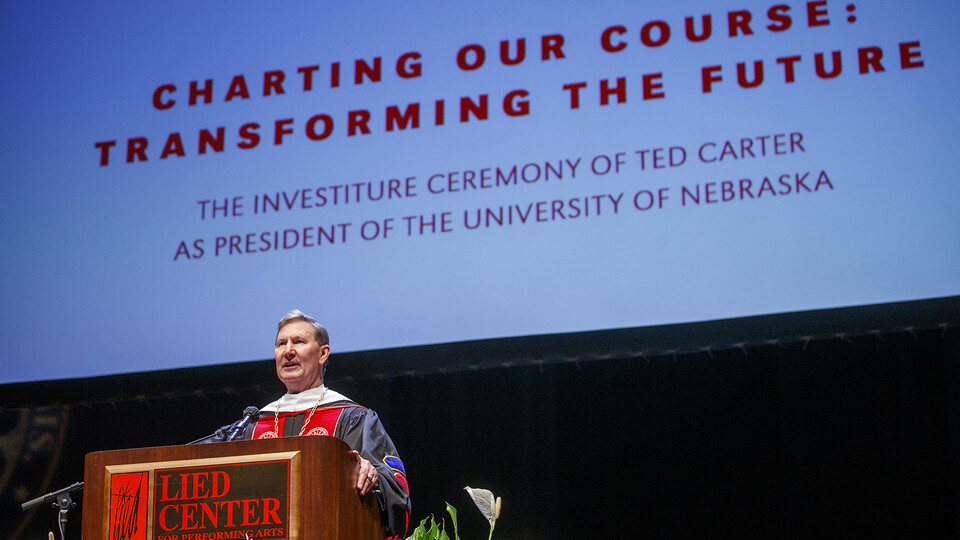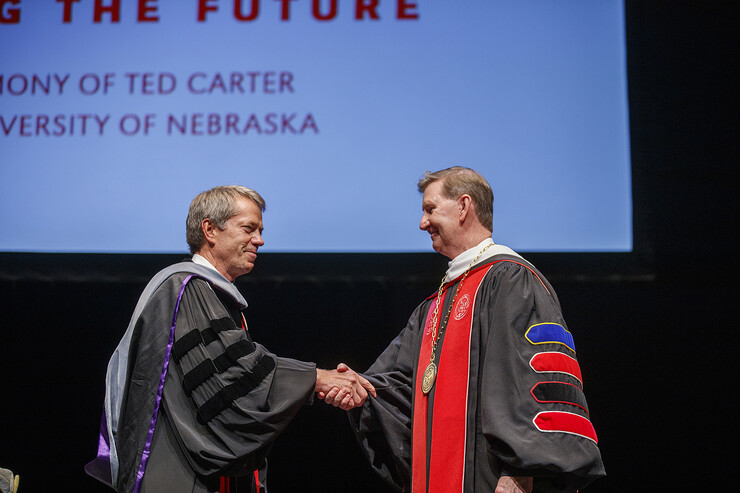· 6 min read
Carter charts path for growth, success

Newly installed University of Nebraska President Ted Carter outlined a multi-year plan for growth and success across the NU system Aug. 19, calling for decisive action to serve the needs of students and the state during a time of great change for higher education.
Carter unveiled the plan during a virtual ceremony formally installing him as the NU system’s eighth president. The plan is informed by months of work by a 28-member, system-wide committee of faculty, staff and students, along with input from the Board of Regents, chancellors, alumni, leaders in business and agriculture, elected officials and others. Carter began as NU president on Jan. 1.
“This document speaks to who are as Nebraskans — that ‘it factor’ that sets us apart from everyone else,” Carter said. “We work hard, we have a commitment to students, and we understand the value of getting things done.
“This is a unique moment for higher education, and this year especially has tested us. The question is, How will we respond? The institutions that succeed — and the University of Nebraska will be among them — will be those that have a bias for action, that are adaptable and creative, and that are willing to think differently. Our plan is all about providing hope, trust, predictability and positive outcomes for the people of Nebraska. I couldn’t be more excited or confident about our future.”
Board of Regents Chairman Jim Pillen of Columbus, who chaired the committee that conducted the national search resulting in Carter’s selection last year, presided over the installation ceremony. Gov. Pete Ricketts served as keynote speaker, and faculty, staff, administrators, students and Nebraskans offered video greetings.
“The University of Nebraska is an integral part of our culture. It’s a part of who we are as Nebraskans,” Ricketts said. “Ted Carter is a man who has lived a life of service. As I’ve gotten to know President Carter, I have seen in him the traits that will serve him well. We are getting a top gun leader at a top gun university, who will help us put together that strategy for how to take the university to the next level, to prepare our young people to lead this state going forward, and to grow Nebraska.”
The plan released by Carter — grounded in the belief that the value of higher education, and a University of Nebraska education in particular, is clear and growing — covers five broad themes:
Student access, affordability and attainment. The affordability, accessibility and quality of a University of Nebraska education is NU’s “North Star,” Carter said, noting that cost should not be a barrier for any Nebraska student to attend an NU campus. He said Nebraskans have a fundamental expectation of their university that their sons and daughters can earn a timely degree at an affordable cost and be prepared for success in life and work.
Workforce development. The state will have more than 34,000 annual openings in high-need areas like engineering, nursing, information technology and healthcare in the years ahead, as well as a critical need for excellent teachers and future generations of farmers and ranchers. Increased pathways to higher education and to the workforce will be critical to meeting the economic needs of the state.
Culture, diversity and inclusion. “Themes of equity and inclusion must touch everything we do,” Carter said. “A growing, thriving University of Nebraska depends on the voices, ideas and success of all members of our community.” Carter said the university will be proactive in identifying opportunities to create a more inclusive and welcome culture, a high priority for both students and employees.
Partnerships. Urgent challenges cannot be solved alone. Carter said the university will work to strengthen partnerships among its campuses, with other higher education institutions, with donors and alumni, elected leaders, the agriculture and business communities, and — most importantly — the people of Nebraska.
Efficiency and effectiveness. “Nebraskans expect their university to operate with common sense,” Carter said. “We won’t spend money we don’t have, we will take care of the resources we do have, and we will continually look for opportunities to become leaner, more effective and more efficient.”
Carter noted that the plan aims to supplement existing strategic plans led by the chancellors of University of Nebraska–Lincoln, University of Nebraska at Omaha, University of Nebraska at Kearney and University of Nebraska Medical Center. Its specific goals include:
Evaluate all university-imposed costs to students and limit increases as much as possible. The Nebraska Promise, a program that covers tuition costs for low- and middle-income Nebraskans, was an early idea to emerge from the strategic planning process; Carter launched it in April given the financial challenges facing students and families during the pandemic.
Adopt a four-year undergraduate graduation guarantee.
Shift the university’s undergraduate tuition model from a “per credit” hour structure to a “block” structure, incentivizing students to take a full course load and graduate on time.
Evaluate innovative academic calendar models to accelerate students’ time to graduation.
Develop tuition pricing and scholarship programs to attract more new Nebraskans to the state in order to meet workforce and economic needs.
Develop a comprehensive plan to address NU’s facilities, infrastructure and information technology needs. Noting the facilities play a key role in attracting and retaining top talent, Carter launched a long-term building renewal and repair plan that will ensure world-class facilities for faculty, staff and students.
Build models to guarantee internships, jobs and debt forgiveness for graduates.
Develop implicit bias training for all employees and conduct regular climate surveys and develop action plans based on the resulting data.
Commit to no net growth in state-aided, non-faculty FTEs at UNL, UNMC and Central Administration until faculty salaries at UNL and UNMC — which have lagged their peers for too long — reach the peer averages. Competitive compensation is a key component of recruiting and retaining excellent faculty, Carter said.
Identify and reduce gender and racial equity pay gaps.
Focus investments on areas of strength and state, national and global importance: Water and food security, rural community vitality, infectious disease, national and cyber security, and early childhood education.
Increase the number of annual donors to the university to 75,000 by 2027 and increase total annual private support to $300 million by 2027.
Launch a “red tape” initiative to identify opportunities to reduce costs and increase efficiency and effectiveness.
Set and achieve university-wide sustainability goals.
A key component of the plan’s execution will be regular and public reporting on the university system’s progress against specific metrics. Carter pledged to provide frequent updates to the Board of Regents and Nebraskans.
“The trust and confidence of the people of Nebraska is our most precious asset,” he said. “We will work every day to earn it.”








